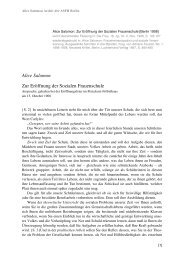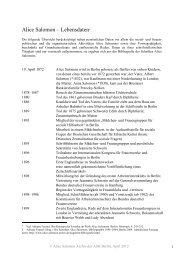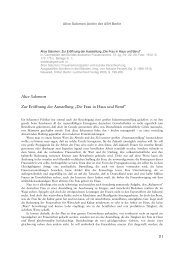Teaching Gender in Social Work - MailChimp
Teaching Gender in Social Work - MailChimp
Teaching Gender in Social Work - MailChimp
You also want an ePaper? Increase the reach of your titles
YUMPU automatically turns print PDFs into web optimized ePapers that Google loves.
As an example of what it meant for men to have the power to decide<br />
which tasks were performed by whom, it should be mentioned that <strong>in</strong> positions<br />
of non-<strong>in</strong>stitutional care the formal education of men was lower than that of<br />
women <strong>in</strong> spite of men’s relatively higher status. The boom of therapeutic social<br />
work among families from the 1940s onwards sealed the gender divisions.<br />
In addition, it resulted <strong>in</strong> a new type of male dom<strong>in</strong>ance, as professionals,<br />
<strong>in</strong>clud<strong>in</strong>g medical doctors, acquired <strong>in</strong>fluence over social work.<br />
Conclud<strong>in</strong>g Remarks<br />
The formation of gender division <strong>in</strong> F<strong>in</strong>nish social work was connected with<br />
many ongo<strong>in</strong>g social processes, not least with the policies of the state towards<br />
the nuclear family of wage labour. In the <strong>in</strong>itial stages, dur<strong>in</strong>g the period of<br />
poor house policies when there was no positive support for the family, women<br />
were quite free to govern their activities by themselves, if they agreed with the<br />
official policy. When the state began to undertake supportive and educative<br />
<strong>in</strong>tervention <strong>in</strong> the everyday lives of families, for which it required female<br />
skills and labour, it was necessary to br<strong>in</strong>g the reproductive work of women of<br />
various classes under control. This control was exercised at two levels, plac<strong>in</strong>g<br />
lower-class family life under the control of upper- and middle-class women<br />
and ensur<strong>in</strong>g that the women’s work was done <strong>in</strong> a controlled way that fulfilled<br />
the hidden purposes of the policy.<br />
The control of women’s work proceeded <strong>in</strong> three stages: at first it<br />
concerned only the criteria of almsgiv<strong>in</strong>g. The second step was the Elberfeldian<br />
visit<strong>in</strong>g, which <strong>in</strong>cluded a visitor’s duty to report the conditions of the poor –<br />
partly <strong>in</strong> writ<strong>in</strong>g − to the Poor Law committee of men responsible for decision<br />
mak<strong>in</strong>g. The third step was the social welfare bureaucracy, where the top level<br />
belonged to men but the grass-roots work required good hearted females. This<br />
illustrates how social policy tended, from the outset, to favour women’s work<br />
and to ma<strong>in</strong>ta<strong>in</strong> the exist<strong>in</strong>g gender order.<br />
As soon as the “paradigm” of social work arose <strong>in</strong> the societal context of<br />
early capitalism, a press<strong>in</strong>g issue was the ability of the actors to harmonise the<br />
pr<strong>in</strong>ciples of economy and emotion. This found expression, for example, <strong>in</strong><br />
the management of the poor house and <strong>in</strong> decisions <strong>in</strong> Poor Law Committees<br />
concern<strong>in</strong>g the f<strong>in</strong>ancial support offered to homes. The issue was particularly<br />
acute <strong>in</strong> grass-roots work, and so the impact on women was different. At the<br />
47














